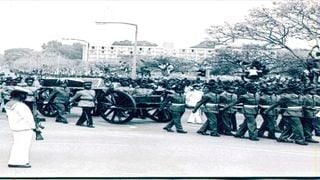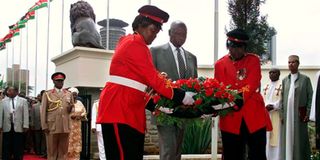
Mzee Jomo Kenyatta's funeral procession by Kenyan soldiers in 1978.
| File | Nation Media groupNews
Premium
Secret funeral plans that Mzee Jomo Kenyatta outlived
What you need to know:
- Due to his ill health, plan for Jomo Kenyatta's funeral started as early as 1968.
- Mzee Jomo Kenyatta, Kenya's founding president, died on August 22, 1978
One of the most closely guarded secrets in Kenya was the state of health of the founding father Mzee Jomo Kenyatta. Today, the Nation can shed light on Mzee Kenyatta’s health and elaborate plans made for his funeral, based on various declassified British intelligence documents.
The secrecy with which the President’s health was handled did not stop rumours about his struggle with various diseases, including angina, gout and oedema. In mid-1966, he also had a blood clot in the leg. Although the blood clot was dispersed successfully, Mzee Kenyatta continued to suffer from recurrent inflammation of the veins (phlebitis).
There were clear signs that he was slowing down. While he was in control of affairs of the state, he found he was unable to work for more than four or five hours consistently.
By 1967, those close to him were giving him another two years of political life before he exited the scene, while those in his inner circle, albeit with some bravado, said they expected him to last longer provided he was not overworked .
Mzee Kenyatta himself took things easy, spending several months of the year at his Bamburi beach house in Mombasa, to relax and alleviate his blood circulation problems. He also invariably preferred the clean air of his Gatundu farm to a night at State House Nairobi.
Nevertheless, the fact remained that Mzee Kenyatta was an old man, and it would have been sanguine for one to expect him to maintain his physical and mental power to rule for long. Death from natural causes or resignation due to disability or weariness had to be counted as real possibilities.
In May 1968, Mzee Kenyatta suffered a massive heart attack and went into a coma triggering a serious crisis in the government. The President’s serious indisposition did not only expose the danger of prolonged uncertainty in the choice of heir-apparent, but also exposed the complete lack of forward planning in case of his death or serious illness.
Widespread rumours
Immediately he fell sick, the British diplomats who through their intelligence sources had already received the information, quickly informed London in a confidential telegram (Number 1530) on May 6, 1968.
“There is evidence that Kenyatta is ill in Mombasa, but we do not (repeat not) yet know how seriously,” read the telegram.
The next day, Mr Bruce Greatbatch, the Deputy British High Commissioner met Charles Njonjo, who had just arrived from Mombasa, to know the condition of Mzee Kenyatta. According to details of the meeting, Njonjo dismissed the information as rumours, saying that he (Njonjo) and vice-president Daniel Moi had a meeting with Mzee Kenyatta, who had also phoned him twice that morning with instructions. “The President is as strong as a horse,” said Njonjo.
In response, Greatbatch observed that if that was the case then the government should issue a statement to kill the widespread rumours. Njonjo resisted this, saying that such a move could only make matters worse. He went on to reveal that the President would appear on TV that night to confirm that he was indeed in good health.
Just one hour after this meeting , Mzee Kenyatta’s physician and Cabinet minister Njoroge Mungai issued a press statement through the Kenya News Agency revealing that “Mzee has had a fever but has responded well to treatment.” The doctor added that “Mzee Kenyatta now needs a few days rest before resuming engagement at the Coast.” The statement, although devoid of facts, finally confirmed the rumours that Mzee Kenyatta was unwell. After being in a coma for a couple of days, Mzee Kenyatta regained consciousness and continued to discharge his duties as President.
That same month the British Secretary of State arrived in Kenya where he held a secret meeting with Minister for Agriculture Bruce McKenzie, who was also a member of Mzee Kenyatta’s inner circle. One of the major points of concern for McKenzie was how the information about the President’s health had been handled .
He revealed to the Secretary of State that Mzee Kenyatta was taken ill at lunch time on a Saturday, but vice-president Moi was not told until Sunday afternoon. Attorney-General Njonjo did not hear until Sunday evening , Police Commissioner Bernard Hinga was told at Sunday lunch time and the Head of Special Branch knew nothing until Monday morning.
This underlined the need to draw up urgent and carefully thought out plans and procedures that were to be followed if the President was to be taken ill or died. At this meeting, the Secretary of State and McKenzie agreed that with the discreet involvement of the British government, it was necessary to start putting the necessary contingency measures in place.

Former President, Daniel arap Moi, lays a wreath of flowers at Mzee Jomo Kenyatta's mausoleum on August 22, 2001 to commemorate the 23rd anniversary of Kenya's first president's death.
The only hurdle, according to McKenzie, was how to draft the contingency plan without causing panic and rumours within the government. “President himself must not be aware of these preparations as any suggestion that he could not be long in this world might upset him,” McKenzie said .
He proposed that only a small circle in the government made up of himself, Njonjo and Moi should know.
By June 19, 1968 a small team led by McKenzie had already come up with a draft plan after holding three lengthy meetings. Others in this team included Deputy British High Commissioner, Major-General Bernard Penfold, the head of Kenya’s military, and John Ling, the first Secretary at the British High Commission . Mackenzie had also roped in Colonel John Slim of the elite British Special Air Service (SAS), who was in the country to train GSU personnel.
McKenzie chose not to involve Moi and Njonjo in the drafting of the plan and only presented it to them for consideration at a meeting he convened on the same day. In presenting the draft, he never mentioned the British involvement but presented it as his own. The plan was marked “ top secret” and titled, “Contingency plan for arrangements in the event of the President’s serious illness or death.”
Among the proposals was that “because of his age Kenyatta should have a panel of six eminent doctors, one of whom by turn is always on call”.
A fully equipped motorised medical unit, staffed with a nurse and a doctor was to accompany Kenyatta in his tours. Other proposals included an elaborate state funeral and security measures that were to be put in place upon Mzee Kenyatta’s death, with telephone communication between Nairobi and Nyanza being closely monitored.
McKenzie, in the company of Colonel JR Anderson, who was the Chief of Staff at Kenya Defence headquarters, would later take the draft plan to London for further action by the Commonwealth Office. They also carried with them Nairobi street maps, plans of State House and St Andrews Church.
They had also been advised to bring the plan of Mzee Kenyatta’s house at Gatundu, and photographs of the proposed burial site, but were unable to obtain them because it was difficult to get a plan of the President’s Gatundu house, and a final decision had not yet been reached about where Mzee Kenyatta was to be buried.
Mzee Kenyatta's death
While in London, McKenzie held meetings with the Lord Chamberlain, the senior most official of the Royal family whose duties included organising ceremonial activities such as State funerals, State opening of parliament and Royal weddings. The Lord Chamberlain’s office was ready to give advice to Kenyan officials on the ceremonial aspect of Mzee Kenyatta’s funeral. In this regard, he provided copies of previous ceremonies such as the state funeral of King George IV, which were to serve as templates for Mzee Kenyatta’s funeral.
He also introduced the two Kenyan officials to “Royal undertaker,” JH Kenyon Funeral Directors, who were to be entrusted with Mzee Kenyatta’s funeral. The firm had been entrusted with the funeral services of Sir Winston Churchill, King George VI in 1952 and Queen Mary in 1953.
Despite all these advance arrangements , Mzee Kenyatta went on to live far beyond what many had expected, that some of the proposals had to be revised. McKenzie, who was at the forefront in making the arrangements, died in May 1978, three months before Mzee Kenyatta. But still, because of Mzee Kenyatta’s stature as a leading African statesman and for security and political reasons, there had to be advance preparations for his eventual demise.
In April 1977 , slightly over a year before his death , there was a flurry of letters between the British Prime Minister’s Office, Foreign and Commonwealth Office and Buckingham Palace about the representatives , who were to be sent to Kenya in the event of Mzee Kenyatta’s death.
The Foreign and Commonwealth Office in a letter to Buckingham Palace, dated April 12, 1977 recommended for the Queen to be represented by a senior member of the Royal family “at the highest level possible” because of Mzee Kenyatta’s stature and the long standing links between Kenya and Britain. They recommended Prince Philip or Prince Charles
In another letter to the Prime Minister’s office, the FCO recommended, “Because of Kenyatta’s achievements and the importance of Kenya to us, a decision of principle should be taken that HM government should be represented at the funeral by a Minister of Cabinet rank.” The Prime Minister’s Office endorsed the proposal and recommended the Lord Chancellor or the Secretary of State for Foreign and Commonwealth Office.
Mzee Kenyatta eventually died on August 22, 1978, and was given an elaborate state funeral attended by heads of state and government officials from different countries. Britain and America sent some of the largest delegations from the West ever witnessed in Africa at that time.
The writer is a London-based Kenyan journalist and researcher.





